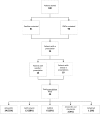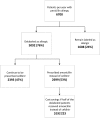Antibiotic Use After Removal of Penicillin Allergy Label
- PMID: 29678929
- PMCID: PMC5914488
- DOI: 10.1542/peds.2017-3466
Antibiotic Use After Removal of Penicillin Allergy Label
Abstract
Background: Penicillin allergy is commonly reported in the pediatric emergency department. We previously performed 3-tier penicillin allergy testing on children with low-risk symptoms, and 100% tolerated a penicillin challenge without an allergic reaction. We hypothesized that no serious allergic reactions would occur after re-exposure to penicillin and that prescription practices would change after testing.
Methods: We performed a follow-up case series of 100 children whose test results were negative for penicillin allergy. Research staff administered a brief follow-up phone survey to the parent and primary care provider of each patient tested. We combined the survey data and summarized baseline patient characteristics and questionnaire responses. We then completed a 3-tier economic analysis from the prescription information gathered from surveys in which cost savings, cost avoidance, and potential cost savings were calculated.
Results: A total of 46 prescriptions in 36 patients were reported by the primary care provider and/or parents within the year after patients were tested for penicillin allergy. Twenty-six (58%) of the prescriptions filled were penicillin derivatives. One (4%) child developed a rash 24 hours after starting the medication; no child developed a serious adverse reaction after being given a penicillin challenge. We found that the cost savings of delabeling patients as penicillin allergic was $1368.13, the cost avoidance was $1812.00, and the total potential cost savings for the pediatric emergency department population was $192 223.00.
Conclusions: Children with low-risk penicillin allergy symptoms whose test results were negative for penicillin allergy tolerated a penicillin challenge without a severe allergic reaction developing. Delabeling children changed prescription behavior and led to actual health care savings.
Copyright © 2018 by the American Academy of Pediatrics.
Conflict of interest statement
POTENTIAL CONFLICT OF INTEREST: The authors have indicated they have no potential conflicts of interest to disclose.
Figures
References
-
- Mendelson LM. Adverse reactions to β-lactam antibiotics. Immunol Allergy Clin North Am. 1998;18(4):745–757
-
- Nicklas R, Bernstein IL, Li JT, et al. . β-lactam antibiotics: the diagnosis and management of anaphylaxis. J Allergy Clin Immunol. 1999;101:S498–S501
-
- Kerr JR. Penicillin allergy: a study of incidence as reported by patients. Br J Clin Pract. 1994;48(1):5–7 - PubMed
-
- Ahlstedt S. Penicillin allergy—can the incidence be reduced? Allergy. 1984;39(3):151–164 - PubMed
Publication types
MeSH terms
Substances
Grants and funding
LinkOut - more resources
Full Text Sources
Other Literature Sources
Medical



